| The
Spathology of Medieval and Renaissance Sword Forms
In the continuing effort
to bring greater learning and scholarship to the serious study and
practice of European weaponry, ARMA, as the premier Internet site
for Medieval and Renaissance fighting arts, presents the following
general definitions. This brief list is intended to aid students in
study and dispel some of the many myths and misconceptions surrounding
the subject.
Swords from the
Dark Ages to the
High Middle Ages
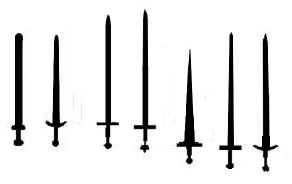 Medieval
swords existed in great varieties over a number of centuries. Both
experimentation and specialization in design was constant. But certain
common characteristics can describe the "generic" medieval sword as
a long, wide, straight, double-edged blade with a simple cross-guard
(or "cruciform" hilt). It might be designed for one or two-hands.
The typical form was a single hand weapon used for hacking, shearing
cuts and also for limited thrusting. This style developed essentially
from Celtic, Germanic, Anglo-Saxon, and late Roman (the spatha)
forms. The Viking and early Frankish forms (the "spata")
are also considered to be more direct ancestors. Medieval swords can
be classified (typically by hilt design) into a great many categories
by curators, collectors, and military historians. However, students
& re-creationists today should prefer the actual historical terms.
At the time, long bladed weapons were simply referred to as "swords,"
or for the longer ones often a "sword of war," "war-sword" (French
or), or even a "long-sword." Various languages might call them by
Espée
du Guerreschwert,
svard,
suerd,
swerd,
espada,
esapadon,
or epee. When later worn on the belt by mounted knights they might
be called an Arming-sword. Arming-swords were also considered "riding-swords"
(also parva
ensis
or epee
courte).
It is this single-hand form which is so closely associated with the
idea of the "knightly sword" (c. 1300). The challenge of armor in
the Age-of-plate, forced many blades (both single-hand and longer)
to be made narrower and pointier, but also thicker and more rigid.
From at least the late 1300’s in England, a single-hand blade
of this form was referred as a "short swerde." In 15th century
Germany, it was the Kurczen
swert.
At this same time, as a result of the increased use of thrusting techniques
some blades adopted guards with knuckle-bars, finger-rings, and/or
sides-rings which lead to the compound-hilt. In later Elizabethan
times, older one-handed medieval type blades became known as "short-swords"
while the larger variety were still referred to as "long-swords."
The term "short sword" was used later by 19th century collectors to
refer to any style of "shorter" one-handed swords typically from ancient
times on. Medieval
swords existed in great varieties over a number of centuries. Both
experimentation and specialization in design was constant. But certain
common characteristics can describe the "generic" medieval sword as
a long, wide, straight, double-edged blade with a simple cross-guard
(or "cruciform" hilt). It might be designed for one or two-hands.
The typical form was a single hand weapon used for hacking, shearing
cuts and also for limited thrusting. This style developed essentially
from Celtic, Germanic, Anglo-Saxon, and late Roman (the spatha)
forms. The Viking and early Frankish forms (the "spata")
are also considered to be more direct ancestors. Medieval swords can
be classified (typically by hilt design) into a great many categories
by curators, collectors, and military historians. However, students
& re-creationists today should prefer the actual historical terms.
At the time, long bladed weapons were simply referred to as "swords,"
or for the longer ones often a "sword of war," "war-sword" (French
or), or even a "long-sword." Various languages might call them by
Espée
du Guerreschwert,
svard,
suerd,
swerd,
espada,
esapadon,
or epee. When later worn on the belt by mounted knights they might
be called an Arming-sword. Arming-swords were also considered "riding-swords"
(also parva
ensis
or epee
courte).
It is this single-hand form which is so closely associated with the
idea of the "knightly sword" (c. 1300). The challenge of armor in
the Age-of-plate, forced many blades (both single-hand and longer)
to be made narrower and pointier, but also thicker and more rigid.
From at least the late 1300’s in England, a single-hand blade
of this form was referred as a "short swerde." In 15th century
Germany, it was the Kurczen
swert.
At this same time, as a result of the increased use of thrusting techniques
some blades adopted guards with knuckle-bars, finger-rings, and/or
sides-rings which lead to the compound-hilt. In later Elizabethan
times, older one-handed medieval type blades became known as "short-swords"
while the larger variety were still referred to as "long-swords."
The term "short sword" was used later by 19th century collectors to
refer to any style of "shorter" one-handed swords typically from ancient
times on.
The Viking Sword
 From
mostly the 8th to 11th centuries, Norse swords were noted for the
unique design and the tempering patterns that were often visible in
their blades. What made the weapon stand out was that it was resilient
and robust against the kinds of armor and shields they regularly encountered.
Wielded one-handed in conjunction with a shield it could make
ferocious slashes and chops, deliver good thrusts, do all this without
breaking or bending yet still hold a keen edge. It combined
sturdy reliability and sharpness with lightness and strength to make
a versatile weapon that in the right hands could penetrate hard chain
or leather armor as well as softer furs and cloth. That
it was also a beautiful object whose manufacture was part mystery
only added to its allure. Though the Norse came to eventually
adopt easier to produce designs of continental origin, and also used
short single-edge blades, such as the scramasax
or scramanseaxe (from
which the Saxon people derive their name), it is the double edge variety
with a wide flat pommel and short guard that became associated with
them. From
mostly the 8th to 11th centuries, Norse swords were noted for the
unique design and the tempering patterns that were often visible in
their blades. What made the weapon stand out was that it was resilient
and robust against the kinds of armor and shields they regularly encountered.
Wielded one-handed in conjunction with a shield it could make
ferocious slashes and chops, deliver good thrusts, do all this without
breaking or bending yet still hold a keen edge. It combined
sturdy reliability and sharpness with lightness and strength to make
a versatile weapon that in the right hands could penetrate hard chain
or leather armor as well as softer furs and cloth. That
it was also a beautiful object whose manufacture was part mystery
only added to its allure. Though the Norse came to eventually
adopt easier to produce designs of continental origin, and also used
short single-edge blades, such as the scramasax
or scramanseaxe (from
which the Saxon people derive their name), it is the double edge variety
with a wide flat pommel and short guard that became associated with
them.
The Broadsword
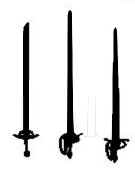 A
term popularly misapplied as a generic synonym for medieval swords
or any long, wide military blade. The now popular misnomer "broadsword"
in reference to Medieval blades actually originated with collectors
in the early 19th century -although many mistranslations and misinterpretations
of Medieval literature during the 19th and 20th centuries have inserted
the word broadsword in place of other terms. They described
swords of earlier ages as being "broader" than their own contemporary
thinner ones. Many 17th-19th century blades such as spadroons, cutlasses,
and straight sabers are classed as broadswords as are other closed
hilt military swords. The weapon known as the true broadsword is in
fact a form of short cutlass. The term "broadsword" does not appear
in English military texts from the 1570s - 1630s and noes not show
up in inventories of sword types from the 1630's, and likely came
into use sometime between 1619 and 1630. Descriptions of swords as
"broad" before this time are only incidental and the word "broad"
is used as an adjective in the same way "sharp" or "large" would be
applied. Leading arms curators almost always list the broadsword specifically
as a close-hilted military sword from the second half of the 17th
century. Those cage and basket hilted blades used by cavalry
starting in the 1640's were in form, "broadswords." During this time
a gentleman's blade had become the slender small-sword, whereas the
military used various cutting blades. Today, arms collectors, museum
curators theatrical-fighters, and fantasy-gamers have made the word
broadsword a common, albeit blatantly historically incorrect, term
for the Medieval sword. A
term popularly misapplied as a generic synonym for medieval swords
or any long, wide military blade. The now popular misnomer "broadsword"
in reference to Medieval blades actually originated with collectors
in the early 19th century -although many mistranslations and misinterpretations
of Medieval literature during the 19th and 20th centuries have inserted
the word broadsword in place of other terms. They described
swords of earlier ages as being "broader" than their own contemporary
thinner ones. Many 17th-19th century blades such as spadroons, cutlasses,
and straight sabers are classed as broadswords as are other closed
hilt military swords. The weapon known as the true broadsword is in
fact a form of short cutlass. The term "broadsword" does not appear
in English military texts from the 1570s - 1630s and noes not show
up in inventories of sword types from the 1630's, and likely came
into use sometime between 1619 and 1630. Descriptions of swords as
"broad" before this time are only incidental and the word "broad"
is used as an adjective in the same way "sharp" or "large" would be
applied. Leading arms curators almost always list the broadsword specifically
as a close-hilted military sword from the second half of the 17th
century. Those cage and basket hilted blades used by cavalry
starting in the 1640's were in form, "broadswords." During this time
a gentleman's blade had become the slender small-sword, whereas the
military used various cutting blades. Today, arms collectors, museum
curators theatrical-fighters, and fantasy-gamers have made the word
broadsword a common, albeit blatantly historically incorrect, term
for the Medieval sword.
Long-Swords
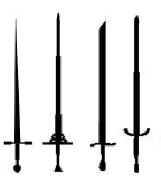 The
various kinds of long bladed Medieval swords that had handles long
enough to be used in two hands were deemed long-swords (German Langenschwert/
Langes
Swert
or Italian spada
longa).
Long-swords,
war-swords,
or great
swords
are characterized by having both
a long grip and a long blade. We know at the time that Medieval warriors
did distinguished war-swords or great-swords ("grant espees" or "grete
swerdes") from "standard" swords in general, but long-swords were
really just those larger versions of typical one-handed swords, except
with stouter blades. They were "longer swords," as opposed to single-hand
swords, or just "swords." They could be used on foot or mounted and
sometimes even with a shield. The term war-sword from the 1300's referred
to larger swords that were carried in battle. They were usually kept
on the saddle as opposed to worn on the belt. A 15th century
Burgundian manual refers to both "great and small swords." As a convenient
classification, long-swords include great-swords, bastard-swords,
and estocs. In the 1200’s in England blunt swords for non-lethal
tournaments were sometimes known as "arms of courtesy." There is a
reference to an English tournament of 1507 in which among the events
contestants are challenged to "8 strookes with Swords rebated." Wooden
training weapons were sometimes called wasters
in the 1200's or batons
in the 1300's and 1400's. Knightly combat with blunt or "foyled" weapons
for pleasure was known as à
plaisance,
combat to the death was à
lóuutrance.
In Germanic lands during, special practice longswords with flexible
blunt blades and rounded points were usually known as Federschwerter
or "feather-swords." The
various kinds of long bladed Medieval swords that had handles long
enough to be used in two hands were deemed long-swords (German Langenschwert/
Langes
Swert
or Italian spada
longa).
Long-swords,
war-swords,
or great
swords
are characterized by having both
a long grip and a long blade. We know at the time that Medieval warriors
did distinguished war-swords or great-swords ("grant espees" or "grete
swerdes") from "standard" swords in general, but long-swords were
really just those larger versions of typical one-handed swords, except
with stouter blades. They were "longer swords," as opposed to single-hand
swords, or just "swords." They could be used on foot or mounted and
sometimes even with a shield. The term war-sword from the 1300's referred
to larger swords that were carried in battle. They were usually kept
on the saddle as opposed to worn on the belt. A 15th century
Burgundian manual refers to both "great and small swords." As a convenient
classification, long-swords include great-swords, bastard-swords,
and estocs. In the 1200’s in England blunt swords for non-lethal
tournaments were sometimes known as "arms of courtesy." There is a
reference to an English tournament of 1507 in which among the events
contestants are challenged to "8 strookes with Swords rebated." Wooden
training weapons were sometimes called wasters
in the 1200's or batons
in the 1300's and 1400's. Knightly combat with blunt or "foyled" weapons
for pleasure was known as à
plaisance,
combat to the death was à
lóuutrance.
In Germanic lands during, special practice longswords with flexible
blunt blades and rounded points were usually known as Federschwerter
or "feather-swords."
Great-Swords
 Those
blades long and weighty enough to demand a double grip are great-swords.
They are infantry swords which cannot be used in a single-hand. Originally
the term "great-sword" (gret sord, grete swerde,
or grant espée), only meant a war-sword (long-sword), but it
has now more or less come to mean a sub-class of those larger long-swords/war-swords
that are still not true two-handers. They were even known as Grete
Swerdes of Warre or Grans Espees de Guerre. Although they
are "two hand" swords, great-swords not are the specialized weapons
of later two-handed swords. They are the swords that are antecedents
to the even larger Renaissance versions. Great-swords are also the
weapons often depicted in various German sword manuals. A Medieval
great-sword might also be called a "twahandswerds" or "too honde swerd."
Whereas other long-swords could be used on horseback and some even
with shields, great swords however were infantry weapons only. Their
blades might be flat and wide or later on, more narrow and hexagonal
or diamond shaped. These larger swords capable of facing heavier weapons
such as pole-arms and larger axes were devastating against lighter
armors. Long, two-handed swords with narrower, flat hexagonal blades
and thinner tips (such as the Italian "spadone") were a response to
plate-armor. Against plate armor such rigid, narrow, and sharply pointed
swords are not used in the same chop and cleave manner as with flatter,
wider long-swords and great swords. Instead, they are handled with
tighter movements that emphasize their thrusting points and allow
for greater use of the hilt. Those of the earlier parallel-edged shape
are known more as war-swords, while later the thicker, tapering, sharply
pointed form were more often called bastard-swords. One type of long
German sword, the "Rhenish Langenschwert," from the Rhenish city of
Cologne, had a blade of some 4 feet and an enormous grip of some 14
to 16 inches long, not including the pommel. Those
blades long and weighty enough to demand a double grip are great-swords.
They are infantry swords which cannot be used in a single-hand. Originally
the term "great-sword" (gret sord, grete swerde,
or grant espée), only meant a war-sword (long-sword), but it
has now more or less come to mean a sub-class of those larger long-swords/war-swords
that are still not true two-handers. They were even known as Grete
Swerdes of Warre or Grans Espees de Guerre. Although they
are "two hand" swords, great-swords not are the specialized weapons
of later two-handed swords. They are the swords that are antecedents
to the even larger Renaissance versions. Great-swords are also the
weapons often depicted in various German sword manuals. A Medieval
great-sword might also be called a "twahandswerds" or "too honde swerd."
Whereas other long-swords could be used on horseback and some even
with shields, great swords however were infantry weapons only. Their
blades might be flat and wide or later on, more narrow and hexagonal
or diamond shaped. These larger swords capable of facing heavier weapons
such as pole-arms and larger axes were devastating against lighter
armors. Long, two-handed swords with narrower, flat hexagonal blades
and thinner tips (such as the Italian "spadone") were a response to
plate-armor. Against plate armor such rigid, narrow, and sharply pointed
swords are not used in the same chop and cleave manner as with flatter,
wider long-swords and great swords. Instead, they are handled with
tighter movements that emphasize their thrusting points and allow
for greater use of the hilt. Those of the earlier parallel-edged shape
are known more as war-swords, while later the thicker, tapering, sharply
pointed form were more often called bastard-swords. One type of long
German sword, the "Rhenish Langenschwert," from the Rhenish city of
Cologne, had a blade of some 4 feet and an enormous grip of some 14
to 16 inches long, not including the pommel.
Bastard Swords
 In
the early 1400's (as early as 1418) a form of long-sword often with
specially shaped grips for one or two hands, became known as an Espée
Bastarde or "bastard sword." The term may derive not form the
blade length, but because bastard-swords typically had longer handles
with special "half-grips" which could be used by either one or both
hands. In this sense they were neither a one-handed sword nor a true
great-sword/two-handed sword, and thus not a member of either "family"
of sword. Evidence shows the their blade were typically tapered. Since
newer types of shorter swords were coming into use, the term "bastard-sword"
came to distinguish this form of long-sword. Bastard-swords typically
had longer handles with special "half-grips" which could be used by
either one or both hands. These handles have recognizable "waist"
and "bottle" shapes (such grips were later used on the Renaissance
two-handed sword). The unique bastard-sword half-grip was a versatile
and practical innovation. Although, once again classification is not
clear since the term "bastard-sword" appears to have not been entirely
exclusive to those swords with so-called "hand-and-a-half" handles
as older styles of long-sword were still in limited use. Bastard-swords
varied and they might have either a flat blade or narrow hexagonal
one for fighting plate-armor. Some were intended more for cutting
while others were better for thrusting. Bastard swords continued to
be used by knights and men-at-arms into the 1500's. Their hilt style
leads toward the shorter cut & thrust sword forms of the Renaissance.
Strangely, in the early Renaissance the term bastard-sword was also
sometimes used to refer to single-hand arming-swords with compound-hilts.
A form of German arming sword with a bastard-style compound hilt was
called a "Reitschwert" ("cavalry sword") or a "Degen" ("knight's sword").
Although these might have been forms of single-hand estoc. In
the early 1400's (as early as 1418) a form of long-sword often with
specially shaped grips for one or two hands, became known as an Espée
Bastarde or "bastard sword." The term may derive not form the
blade length, but because bastard-swords typically had longer handles
with special "half-grips" which could be used by either one or both
hands. In this sense they were neither a one-handed sword nor a true
great-sword/two-handed sword, and thus not a member of either "family"
of sword. Evidence shows the their blade were typically tapered. Since
newer types of shorter swords were coming into use, the term "bastard-sword"
came to distinguish this form of long-sword. Bastard-swords typically
had longer handles with special "half-grips" which could be used by
either one or both hands. These handles have recognizable "waist"
and "bottle" shapes (such grips were later used on the Renaissance
two-handed sword). The unique bastard-sword half-grip was a versatile
and practical innovation. Although, once again classification is not
clear since the term "bastard-sword" appears to have not been entirely
exclusive to those swords with so-called "hand-and-a-half" handles
as older styles of long-sword were still in limited use. Bastard-swords
varied and they might have either a flat blade or narrow hexagonal
one for fighting plate-armor. Some were intended more for cutting
while others were better for thrusting. Bastard swords continued to
be used by knights and men-at-arms into the 1500's. Their hilt style
leads toward the shorter cut & thrust sword forms of the Renaissance.
Strangely, in the early Renaissance the term bastard-sword was also
sometimes used to refer to single-hand arming-swords with compound-hilts.
A form of German arming sword with a bastard-style compound hilt was
called a "Reitschwert" ("cavalry sword") or a "Degen" ("knight's sword").
Although these might have been forms of single-hand estoc.
The
familiar modern term "hand-and-a-half" was more or less coined to
describe bastards swords specifically. The term "hand-and-a-half sword"
is often used in reference to long-swords is not historical and is
sometimes misapplied to other swords (although during the late 1500's,
long after such blades fell out of favor, some German forms of this
phrase are believed to have been used). While
there is no evidence of the term “hand-and-a-half” having
been used during the Middle Ages, either in English or other languages,
it does appear in the 16th
century. In his 1904 bibliography of Spanish texts, D. Enrique
de Leguina gives a 1564 reference to una
espada estoque de mano y media,
and a 1594 reference to una
espada de mano y media.
In the Ragionamento,
the unpublished appendix to his 1580, Traite
d Escrime
(“Fencing Treatise”), Giovanni Antonio Lovino describes
one sword as una
spada di una mano et mana et meza (literally
“hand and a half sword”) which he distinguishes from the
much larger spada
da due mani
or two-handed sword (the immense Renaissance weapon). The term spadone
was used by Fiore Dei Liberi in 1410 to refer to a tapering long-sword
and Camillo Agrippa in 1550 called the spadone
a war sword. Later it was defined by John Florio in his 1598 Italian-English
dictionary as “a long or two-hand sword.”
Two-handed Swords
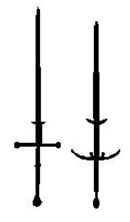 The
term "two-hander" or "two-handed sword" (espée a deure mains
or spada da due mani) was in use as early as 1400 and is really
a classification of sword applied both to Medieval great-swords as
well Renaissance swords (the true two-handed swords). Such weapons
saw more use in the later Middle Ages and early Renaissance. Technically,
true two-handed swords (epee's a deux main) were actually Renaissance,
not Medieval weapons. They are really those specialized forms of the
later 1500-1600's, such as the Swiss/German Dopplehander ("double-hander")
or Bidenhander ("both-hander") or Zweihander / Zweyhander
are relatively modern not historical terms. English ones were sometimes
referred to as "slaughterswords" after the German Schlachterschwerter
("battle swords"). These weapons were used primarily for fighting
against pike-squares where they would hack paths through lobbing the
tips off the poles. In Germany, England, and elsewhere schools also
taught their use for single-combat. In True two-handed swords have
compound-hilts with side-rings and enlarged cross-guards of up to
12 inches. Most have small, pointed lugs or flanges protruding from
their blades 4-8 inches below their guard. These parrierhaken
or "parrying hooks" act almost as a secondary guard for the ricasso
to prevent other weapons from sliding down into the hands. They make
up for the weapon's slowness on the defence and can allow another
blade to be momentarily trapped or bound up. They can also be used
to strike with. The most well-known of "twa handit swordis" is the
Scottish Claymore (Gaelic for "claidheamh-more" or great-sword)
which developed out of earlier Scottish great-swords with which they
are often compared. They were used by the Scottish Highlanders against
the English in the 1500's. Another sword of the same name is the later
Scots basket-hilt broadsword (a relative of the Renaissance Slavic-Italian
schiavona) whose hilt completely enclosed the hand in a cage-like
guard. Both swords have come to be known by the same name since the
late 1700's. Certain wave or flame-bladed two-handed swords have come
to be known by collectors as flamberges, although this is inaccurate.
Such swords developed in the early-to-mid 1500's and are more appropriately
known as flammards or flambards (the German Flammenschwert).
The flamberge was also a term later applied to certain types of rapiers.
The wave-blade form is visually striking but really no more effective
in its cutting than a straight one. There were also huge two-handed
blades known as "bearing-swords" or "parade-swords" (Paratschwert),
weighing up to 12 or even 15 pounds and which were intended only for
carrying in ceremonial processions and parades. In the 1500’s
there were also a few rare single-edged two-handers such as the Swiss-German
Grosse Messer or later sometimes called a Zwiehand sabel. The
term "two-hander" or "two-handed sword" (espée a deure mains
or spada da due mani) was in use as early as 1400 and is really
a classification of sword applied both to Medieval great-swords as
well Renaissance swords (the true two-handed swords). Such weapons
saw more use in the later Middle Ages and early Renaissance. Technically,
true two-handed swords (epee's a deux main) were actually Renaissance,
not Medieval weapons. They are really those specialized forms of the
later 1500-1600's, such as the Swiss/German Dopplehander ("double-hander")
or Bidenhander ("both-hander") or Zweihander / Zweyhander
are relatively modern not historical terms. English ones were sometimes
referred to as "slaughterswords" after the German Schlachterschwerter
("battle swords"). These weapons were used primarily for fighting
against pike-squares where they would hack paths through lobbing the
tips off the poles. In Germany, England, and elsewhere schools also
taught their use for single-combat. In True two-handed swords have
compound-hilts with side-rings and enlarged cross-guards of up to
12 inches. Most have small, pointed lugs or flanges protruding from
their blades 4-8 inches below their guard. These parrierhaken
or "parrying hooks" act almost as a secondary guard for the ricasso
to prevent other weapons from sliding down into the hands. They make
up for the weapon's slowness on the defence and can allow another
blade to be momentarily trapped or bound up. They can also be used
to strike with. The most well-known of "twa handit swordis" is the
Scottish Claymore (Gaelic for "claidheamh-more" or great-sword)
which developed out of earlier Scottish great-swords with which they
are often compared. They were used by the Scottish Highlanders against
the English in the 1500's. Another sword of the same name is the later
Scots basket-hilt broadsword (a relative of the Renaissance Slavic-Italian
schiavona) whose hilt completely enclosed the hand in a cage-like
guard. Both swords have come to be known by the same name since the
late 1700's. Certain wave or flame-bladed two-handed swords have come
to be known by collectors as flamberges, although this is inaccurate.
Such swords developed in the early-to-mid 1500's and are more appropriately
known as flammards or flambards (the German Flammenschwert).
The flamberge was also a term later applied to certain types of rapiers.
The wave-blade form is visually striking but really no more effective
in its cutting than a straight one. There were also huge two-handed
blades known as "bearing-swords" or "parade-swords" (Paratschwert),
weighing up to 12 or even 15 pounds and which were intended only for
carrying in ceremonial processions and parades. In the 1500’s
there were also a few rare single-edged two-handers such as the Swiss-German
Grosse Messer or later sometimes called a Zwiehand sabel.
The Estoc
 A
form of long, rigid, pointed, triangular or square bladed and virtually
edgeless sword designed for thrusting into plate-armor was the estoc.
Called a stocco in Italian, estoque in Spanish,
a tuck in English, Panzerstecher or Dreiecker
in German, and a kanzer in Eastern Europe. They were used
with two hands and similar to great-swords (but were unrelated to
later rapiers). They were used in two hands with the second hand often
gripping the blade. Some were sharpened only near the point and others
might have one or two large round hand guards. Because single-hand
versions persisted even into the 17th century, rapiers are sometimes
mistakenly identified to as tucks, as there is evidence that during
the early 16th century some early rapiers may have been referred to
as such by the English. In French "estoc"
itself means to thrust. A
form of long, rigid, pointed, triangular or square bladed and virtually
edgeless sword designed for thrusting into plate-armor was the estoc.
Called a stocco in Italian, estoque in Spanish,
a tuck in English, Panzerstecher or Dreiecker
in German, and a kanzer in Eastern Europe. They were used
with two hands and similar to great-swords (but were unrelated to
later rapiers). They were used in two hands with the second hand often
gripping the blade. Some were sharpened only near the point and others
might have one or two large round hand guards. Because single-hand
versions persisted even into the 17th century, rapiers are sometimes
mistakenly identified to as tucks, as there is evidence that during
the early 16th century some early rapiers may have been referred to
as such by the English. In French "estoc"
itself means to thrust.
The Claymore
 Identified
with the Scot's symbol of the warrior, the term "Claymore" is Gaelic
for "claidheamh-more" (great sword). This two-handed broadsword was
used by the Scottish Highlanders against the English in the 16th century
and is often confused with a Basket-hilt "broadsword" (a relative
of the Italian schiavona)
whose hilt completely enclosed the hand in a cage- like guard. Both
swords have come to be known by the same name since the late 1700's. Identified
with the Scot's symbol of the warrior, the term "Claymore" is Gaelic
for "claidheamh-more" (great sword). This two-handed broadsword was
used by the Scottish Highlanders against the English in the 16th century
and is often confused with a Basket-hilt "broadsword" (a relative
of the Italian schiavona)
whose hilt completely enclosed the hand in a cage- like guard. Both
swords have come to be known by the same name since the late 1700's.
The Falchion
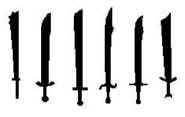 A
rarer form of sword that was little more than a meat cleaver, possibly
even a simple kitchen and barnyard tool adopted for war. Indeed, it
may come from a French word for a sickle, "fauchon."
It can be seen in Medieval art being used against lighter armors by
infidels as well as footman and even knights. The weapon is entirely
European and not derived from eastern sources. More common in the
Renaissance, it was considered a weapon to be proficient with in addition
to the sword. The falchion is similar to the German Dusack
(or Dusagge), and has been dubiously suggested as possibly
related to the Dark Age long knife, "seax" (scramanseax), and
even later curved blades such as sabres (or sabels).
Similar to an Arabian "scimitar," the falchion's wide, heavy blade
weighted more towards the point could deliver tremendous blows. Several
varieties were known, most all with single edges and rounded points.
A later Italian falchion with a slender sabre-like blade was called
a "storta" or a "malchus."
Another similar weapon in German was the saber-like Messer.
Large two-hand versions, called Grosse Messers, with straight
or curved single-edged blades were known by 1500. A
rarer form of sword that was little more than a meat cleaver, possibly
even a simple kitchen and barnyard tool adopted for war. Indeed, it
may come from a French word for a sickle, "fauchon."
It can be seen in Medieval art being used against lighter armors by
infidels as well as footman and even knights. The weapon is entirely
European and not derived from eastern sources. More common in the
Renaissance, it was considered a weapon to be proficient with in addition
to the sword. The falchion is similar to the German Dusack
(or Dusagge), and has been dubiously suggested as possibly
related to the Dark Age long knife, "seax" (scramanseax), and
even later curved blades such as sabres (or sabels).
Similar to an Arabian "scimitar," the falchion's wide, heavy blade
weighted more towards the point could deliver tremendous blows. Several
varieties were known, most all with single edges and rounded points.
A later Italian falchion with a slender sabre-like blade was called
a "storta" or a "malchus."
Another similar weapon in German was the saber-like Messer.
Large two-hand versions, called Grosse Messers, with straight
or curved single-edged blades were known by 1500.
Cut & Thrust Swords
of the Renaissance
 The
generic term "cut and thrust sword" is a general one which can be
applied to a whole range of blade forms (field swords, side-swords,
spada
di lato,
arming swords). However, the Renaissance military sword is generally
characterized by a swept or compound-hilt, a narrow cut-and-thrust
blade with stronger cross-section, and tapering tip. A direct descendant
of the Medieval knightly sword, the cut and thrust sword was used
by lightly armed footmen as well as civilians in the 16th and 17th
centuries. During this time they were employed against a range of
armored and unarmored opponents. They were popular for sword and buckler
and sword and dagger fighting. They utilized an innovative one-handed
grip fingering the ricasso (a dull portion of blade just above the
guard). Renaissance cut and thrust swords should not be referred to
as "early Renaissance swords" since they were actually in use throughout
the period. Military and civilian forms of them existed before, during
and after the development of the rapier. For example, similar blades
(with and without ricassos and compound hilts) saw use in the English
Civil War and even later. They should also not be referred to as "sword-rapiers"
or "early rapiers," although in a sense, some of them were. Renaissance
cut & thrust swords were their own distinct sword type. Although
sometimes considered a "transition" form, this is inaccurate as they
were both the ancestor and contemporary of the rapier for which they
are often misidentified. Some forms of cage and basket hilts blades
are occasionally referred to as "riding swords" by collectors and
curators, and sometimes even as "broadswords." However, the 16th century
Italians did sometimes distinguish between spada
da cavallo,
or a blade for horsemen, spada
da fante,
an infantry sword for foot-soldiers, and later spada
da lato
(side sword), a civilian cut-and-thrust sword, a form of which only
later became the rapier (in modern times sometimes called a stricia). The
generic term "cut and thrust sword" is a general one which can be
applied to a whole range of blade forms (field swords, side-swords,
spada
di lato,
arming swords). However, the Renaissance military sword is generally
characterized by a swept or compound-hilt, a narrow cut-and-thrust
blade with stronger cross-section, and tapering tip. A direct descendant
of the Medieval knightly sword, the cut and thrust sword was used
by lightly armed footmen as well as civilians in the 16th and 17th
centuries. During this time they were employed against a range of
armored and unarmored opponents. They were popular for sword and buckler
and sword and dagger fighting. They utilized an innovative one-handed
grip fingering the ricasso (a dull portion of blade just above the
guard). Renaissance cut and thrust swords should not be referred to
as "early Renaissance swords" since they were actually in use throughout
the period. Military and civilian forms of them existed before, during
and after the development of the rapier. For example, similar blades
(with and without ricassos and compound hilts) saw use in the English
Civil War and even later. They should also not be referred to as "sword-rapiers"
or "early rapiers," although in a sense, some of them were. Renaissance
cut & thrust swords were their own distinct sword type. Although
sometimes considered a "transition" form, this is inaccurate as they
were both the ancestor and contemporary of the rapier for which they
are often misidentified. Some forms of cage and basket hilts blades
are occasionally referred to as "riding swords" by collectors and
curators, and sometimes even as "broadswords." However, the 16th century
Italians did sometimes distinguish between spada
da cavallo,
or a blade for horsemen, spada
da fante,
an infantry sword for foot-soldiers, and later spada
da lato
(side sword), a civilian cut-and-thrust sword, a form of which only
later became the rapier (in modern times sometimes called a stricia).
The Back-Sword
 The
back-sword or Backe swerd was a less-common form of single-edged
renaissance military cut & thrust blade with a compound-hilt (side-rings
or anneus, finger-rings, knuckle-bar, etc.). Most popular in England
with a buckler or target from at least the 1520’s, it was long
enough for both mounted and infantry and favored because its single-edge
designed allowed for a superior cutting blow. It was also popular
in Germany. Back-swords may be related to later single-edged European
blade forms and came in a variety of hilts and lengths. They also
include later Hangers and hunting swords, as well as Mortuary-hilt
and Walloon-hilt broadswords. The
back-sword or Backe swerd was a less-common form of single-edged
renaissance military cut & thrust blade with a compound-hilt (side-rings
or anneus, finger-rings, knuckle-bar, etc.). Most popular in England
with a buckler or target from at least the 1520’s, it was long
enough for both mounted and infantry and favored because its single-edge
designed allowed for a superior cutting blow. It was also popular
in Germany. Back-swords may be related to later single-edged European
blade forms and came in a variety of hilts and lengths. They also
include later Hangers and hunting swords, as well as Mortuary-hilt
and Walloon-hilt broadswords.
The Schiavona
 A
form of agile Renaissance cut & thrust sword with a decorative
cage-hilt and distinctive "cat-head" pommel. So named for the Schiavoni
or Venetian Doge’s Slavonic mercenaries and guards of the 1500’s
who favored the weapon. They are usually single edged back-swords
but may also be wide or narrow double edged blades. Some have ricasso
for a fingering grip while others have thumb-rings. The Schiavona
is often considered the antecedent to other cage hilt swords such
as the Scottish basket-hilted "broadsword." A
form of agile Renaissance cut & thrust sword with a decorative
cage-hilt and distinctive "cat-head" pommel. So named for the Schiavoni
or Venetian Doge’s Slavonic mercenaries and guards of the 1500’s
who favored the weapon. They are usually single edged back-swords
but may also be wide or narrow double edged blades. Some have ricasso
for a fingering grip while others have thumb-rings. The Schiavona
is often considered the antecedent to other cage hilt swords such
as the Scottish basket-hilted "broadsword."
The Katzbalger
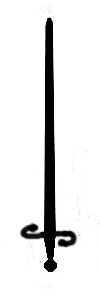 A
form of typically one-handed sword with a shorter blade and invariably
"S" shaped guard. It was favored by pikemen and the Swiss/German Landesknetchs
for fighting close in amidst pike-squares. Many were originally longer,
wider blades which were cut down and remounted. The name likely derives
from a word associated with cat-gut or cat-skin. Their lengths varied
from short to mid-sized. A
form of typically one-handed sword with a shorter blade and invariably
"S" shaped guard. It was favored by pikemen and the Swiss/German Landesknetchs
for fighting close in amidst pike-squares. Many were originally longer,
wider blades which were cut down and remounted. The name likely derives
from a word associated with cat-gut or cat-skin. Their lengths varied
from short to mid-sized.
The Rapier
 Popular
in the late 16th and early 17th centuries, the rapier was a dueling
weapon whose form was developed from cut and thrust swords. Its use
was more brutal and forceful than the light sport fencing that we
know of today. Originally, starting about 1470, any civilian sword
was often referred to as simply a "rapier," but it quickly took on
the meaning of a slender, civilian thrusting sword. There is also
an English document from the 1500's that uses the term "rapier-sword"
for advising courtiers how to be armed, indicating the understanding
that there were new slender blades coming into civilian use. Eventually
developing into an edgeless, ideal thrusting weapon, the quick, innovative
rapier superseded the military cut & thrust sword for personal
duel and urban self-defense. Being capable of making only limited
lacerations, earlier varieties of rapier are still often confused
with the cut and thrust swords which gave gestation to their method.
As a civilian weapon of urban self-defense, a true rapier was a tip-based
thrusting sword that used stabbing and piercing, not slashing and
cleaving. True rapier blades ranged from early flatter triangular
blades to thicker, narrow hexagonal ones. Rapier hilts range from
swept styles, to later dishes and cups. It had no true cutting edge
such as with military swords for war. Popular
in the late 16th and early 17th centuries, the rapier was a dueling
weapon whose form was developed from cut and thrust swords. Its use
was more brutal and forceful than the light sport fencing that we
know of today. Originally, starting about 1470, any civilian sword
was often referred to as simply a "rapier," but it quickly took on
the meaning of a slender, civilian thrusting sword. There is also
an English document from the 1500's that uses the term "rapier-sword"
for advising courtiers how to be armed, indicating the understanding
that there were new slender blades coming into civilian use. Eventually
developing into an edgeless, ideal thrusting weapon, the quick, innovative
rapier superseded the military cut & thrust sword for personal
duel and urban self-defense. Being capable of making only limited
lacerations, earlier varieties of rapier are still often confused
with the cut and thrust swords which gave gestation to their method.
As a civilian weapon of urban self-defense, a true rapier was a tip-based
thrusting sword that used stabbing and piercing, not slashing and
cleaving. True rapier blades ranged from early flatter triangular
blades to thicker, narrow hexagonal ones. Rapier hilts range from
swept styles, to later dishes and cups. It had no true cutting edge
such as with military swords for war.
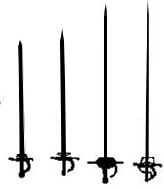 The
so-called "sword-rapier" is actually a term invented by collectors
in the last century and is not a historical one. Increasingly, many
Renaissance cut and thrust swords are mistakenly labeled as such.
With the ascendancy of rapiers over swords in personal duel and private
quarrel, there were many attempts to combine the slashing and cleaving
potential of a traditional military sword with the quick, agile thrust
of a dueling rapier. This lead to a great deal of experimental blade
forms, many of which were dismal failures with neither the cutting
power of wider swords, nor the speed and lightness of true rapiers.
Made to do both, they typically did neither very well and few examples
of these blades forms survive. They do appear to have been popular
with high-ranking military officers during the mid 17th century (who
of course, would be among those least likely to engage in battlefield
hand-to- hand combat). They are also sometimes mistakenly called "cutting
rapiers" or assumed to be some form of "transition" blade between
swords and rapiers. The
so-called "sword-rapier" is actually a term invented by collectors
in the last century and is not a historical one. Increasingly, many
Renaissance cut and thrust swords are mistakenly labeled as such.
With the ascendancy of rapiers over swords in personal duel and private
quarrel, there were many attempts to combine the slashing and cleaving
potential of a traditional military sword with the quick, agile thrust
of a dueling rapier. This lead to a great deal of experimental blade
forms, many of which were dismal failures with neither the cutting
power of wider swords, nor the speed and lightness of true rapiers.
Made to do both, they typically did neither very well and few examples
of these blades forms survive. They do appear to have been popular
with high-ranking military officers during the mid 17th century (who
of course, would be among those least likely to engage in battlefield
hand-to- hand combat). They are also sometimes mistakenly called "cutting
rapiers" or assumed to be some form of "transition" blade between
swords and rapiers.
The Flamberge
 An
unusual waved-bladed rapier popular with officers and upper classes
during the 1600s. It was considered to look both fashionable and deadly
as well as erroneously believed to inflict a more deadly wound. When
parrying with the flamberge,
the opponent's sword was slowed slightly as it passed along the length.
It also created a disconcerting vibration in the other blade. The
term flamberge was also used
later to describe a dish-hilted rapier with a normal straight blade.
Certain wave or flame-bladed two-handed swords have also come to be
known by collectors as "flamberges,"
although this is inaccurate. Such swords are more appropriately known
as "flammards" or "flambards."
Such blade styles exist in numeorus forms and even appear on
two-handed great swords of the 1500s. An
unusual waved-bladed rapier popular with officers and upper classes
during the 1600s. It was considered to look both fashionable and deadly
as well as erroneously believed to inflict a more deadly wound. When
parrying with the flamberge,
the opponent's sword was slowed slightly as it passed along the length.
It also created a disconcerting vibration in the other blade. The
term flamberge was also used
later to describe a dish-hilted rapier with a normal straight blade.
Certain wave or flame-bladed two-handed swords have also come to be
known by collectors as "flamberges,"
although this is inaccurate. Such swords are more appropriately known
as "flammards" or "flambards."
Such blade styles exist in numeorus forms and even appear on
two-handed great swords of the 1500s.
The Baroque Small
Sword
 This
Baroque descendant of the rapier became the gentleman's side-arm of
choice in the 18th century. Sometimes known as a "court-sword," a
"walking-sword," or "town-sword," small-swords developed in the late
Renaissance as a personal dueling tool and weapon of self-defense.
Most popular in the 1700's it is sometimes confused with the rapier.
It consisted almost exclusively of a sharp pointed metal rod with
a much smaller guard and finger-rings. Its blade was typically a hollow
triangular shape and was much thicker at the hilt. Most had no edge
at all, and were merely rigid, pointed, metal rods. Some forms were
simply shortened and re-hilted old rapiers, others were special models
crafted with extra large ricassos to resist the slashes of sabers
and cutlasses. They were popular with the upper classes especially
as decorative fashion accessories, worn like jewelry. In a skilled
hand the small sword was an effective and deadly instrument. Until
the early 1800s it continued to be used even against older rapiers
and even some cutting swords. It is the small-sword rather than the
rapier which leads to the epee and foil of modern sport fencing. This
Baroque descendant of the rapier became the gentleman's side-arm of
choice in the 18th century. Sometimes known as a "court-sword," a
"walking-sword," or "town-sword," small-swords developed in the late
Renaissance as a personal dueling tool and weapon of self-defense.
Most popular in the 1700's it is sometimes confused with the rapier.
It consisted almost exclusively of a sharp pointed metal rod with
a much smaller guard and finger-rings. Its blade was typically a hollow
triangular shape and was much thicker at the hilt. Most had no edge
at all, and were merely rigid, pointed, metal rods. Some forms were
simply shortened and re-hilted old rapiers, others were special models
crafted with extra large ricassos to resist the slashes of sabers
and cutlasses. They were popular with the upper classes especially
as decorative fashion accessories, worn like jewelry. In a skilled
hand the small sword was an effective and deadly instrument. Until
the early 1800s it continued to be used even against older rapiers
and even some cutting swords. It is the small-sword rather than the
rapier which leads to the epee and foil of modern sport fencing.
Curved Blades
in the Medieval and Renaissance Eras
While
it is the straight-bladed cruciform sword style that for both war
and duel was perfected in Europe as no where else, curved swords
were hardly unknown. Many forms were known from the ancient convex-bladed
Greek kopis and Iberian falcatta, to the laengsaex
curved Viking blade, as well as the short-sword/long-knife seax
or scramsax. There is also the Medieval falchion and the German
curved Messer, Grossmessr, and bohemian Dusask
The Italians used the curved storta, the straight bladed but
curved-edge braquemart and the curved badelair (baudelair,
bazelair, or basilaire) as well as the short curved braquet.
Finally, wide varieties of sabers, sabres, sabels, and
cutlasses were used from at least the mid-1500’s. Indigenous
European curved sword forms such as the Czech tesak, Polish
tasak, and Russian tisak were used since at least the
7th century.
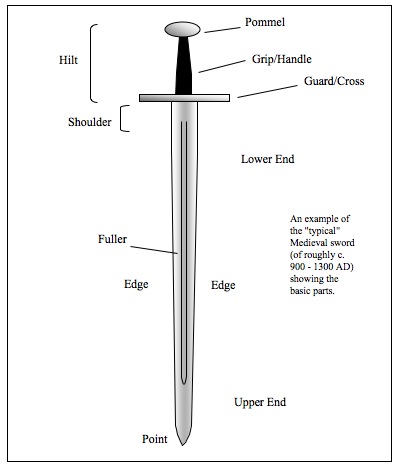 Sword
Parts Sword
Parts
Many
sword types are closely identified with a particular style of hilt.
Yet hilts were very often replaced on blades over time a weapon.
Thus, a sword cannot be classified or categorized by whatever kind
of cross, pommel, or grip it has, but by the length, form, and geometry
of its blade.
Hilt
- The upper portion of a sword consisting of the cross-guard, handle/grip,
and pommel (most Medieval swords have a straight cross or cruciform-hilt).
Called the Handhabe
in German. In Old French the crosspiece was called helz,
the grip called poing, the
pommel called pom, and the
handle might be bound with metal rings called mangon.
Cross
- The typically straight bar or "guard" of a Medieval sword, also
called a "cross-guard." A Renaissance term for the straight or curved
cross-guard was the quillons (possibly from an old French or Latin
term for a type of reed). Fiore Dei Liberi in 1410 referred
to it as the crucibus. Fillipo Vadi in the 1480s termed it
the cross-guard or "crosses," Elza term. Called the Gehiltz
or Gehultz in German. Called the Kreuz in German
and Croce in Italian.
Quillons:
A Renaissance term for the two cross-guards (forward and back) whether
straight or curved. It is likely from an old French or Latin term
for a reed. On Medieval swords the cross guard may be called simply
the "cross," or just the "guard."
Pommel:
Latin for "little apple," the counter-weight which secures the hilt
to the blade and allows the hand either rest on it or grip it.
Forte':
A Renaissance term for the upper portion on a sword blade which has
more control and strength and which does most
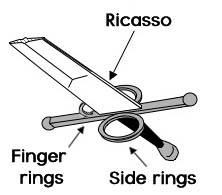 Foible:
A Renaissance term for the lower portion on a sword blade which is
weaker (or "feeble") but has more agility and speed and which does
most of the attacking. Foible:
A Renaissance term for the lower portion on a sword blade which is
weaker (or "feeble") but has more agility and speed and which does
most of the attacking.
Fuller
- A shallow central-groove or channel on a blade which lightens it
as well as improves strength and flex. Sometimes mistakenly called
a "blood-run" or "blood-groove," it has nothing to do with blood flow,
cutting power, or a blade sticking. A sword might have one, none,
or several fullers running a portion of its length, on either one
or both sides. Narrow deep fullers are also sometimes referred to
as flukes. The opposite of a fuller is a riser, which improves rigidity.
Grip
- The handle of a sword, usually made of leather, wire, bone, horn,
or ivory (also, a term for the method of holding the sword).
Lower
end - the tip portion or final quarter of blade on a sword
Pommel
- Latin for "little apple," the counter-weight which secures the hilt
to the blade and allows the hand to either rest on it or grip it.
Sometimes it includes a small rivet (capstan rivet) called a pommel
nut, pommel bolt, or tang nut. On some Medieval swords the pommel
may be partially or fully gripped and handled.
Ricasso
- The dull portion of a blade just above the hilt. It is intended
for wrapping the index finger around to give greater tip control (called
"fingering"). Not all sword forms had ricasso. They can be found on
many Bastard-swords, most cut & thrust swords and later rapiers.
Those on Two-Handed swords are sometimes called a "false-grip," and
usually allow the entire second had to grip and hold on. The origin
of the term is obscure.
Shoulder
- The corner portion of a sword separating the blade from the tang.
Tang
- The un-edged hidden portion or ("tongue") of a blade running through
the handle and to which the pommel is attached. The place where the
tang connects to the blade is called the "shoulder." A sword's tang
is sometimes of a different temper than the blade itself. The origin
of the term is obscure.
Upper
end - The hilt portion of a Medieval sword
Waisted-grip
- A specially shaped handle on some bastard or hand-and-a-half swords,
consisting of a slightly wider middle and tapering towards the pommel.
Annellet/Finger-Ring:
The small loops extending toward the blade from the quillons intended
to protect a finger wrapped over the guard. They developed in the
middle-ages and can be found on many styles of Late-Medieval swords.
They are common on Renaissance cut & thrust swords and rapiers
they and also small-swords. For some time they have been incorrectly
called the "pas d`ane."
Compound-Hilt/Complex-Guard:
A term used for the various forms of hilt found on Renaissance and
some late-Medieval swords. They consist typically of finger-rings,
side-rings or ports, a knuckle-bar, and counter-guard or back-guard.
Swept-hilts, ring-hilts, cage-hilts, and some basket-hilts are forms
of complex-guard.
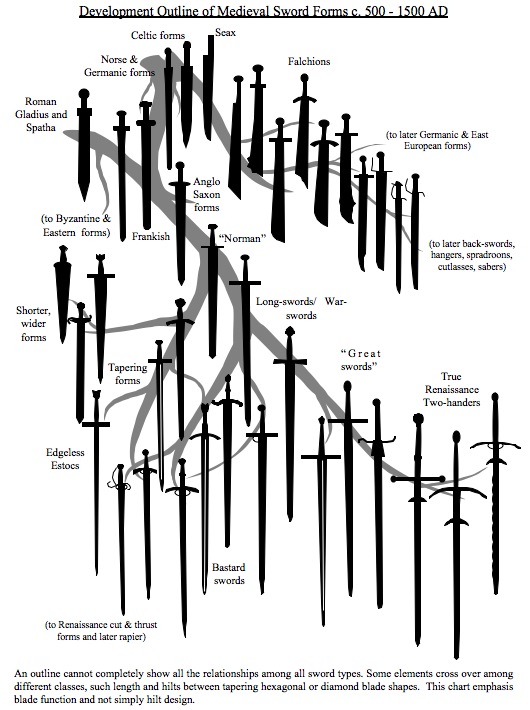
|

